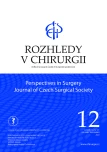Chylothorax treatment with thoracic duct embolization
Authors:
V. Chovanec 1; J. Drugda 2; Miroslav Lojík 1; P. Vodárek 2; P. Žák 2; I. Hanke 3; V. Koblížek 4
Authors‘ workplace:
Radiologická klinika Fakultní nemocnice v Hradci Králové a Lékařská fakulta Univerzity Karlovy v Hradci Králové
1; IV. interní hematologická klinika, Fakultní nemocnice v Hradci Králové a Lékařská fakulta Univerzity Karlovy v Hradci, Králové
2; Kardiochirurgická klinika Fakultní nemocnice v Hradci Králové a Lékařská fakulta Univerzity Karlovy v Hradci Králové
3; Plicní klinika Fakultní nemocnice v Hradci Králové a Lékařská fakulta Univerzity Karlovy v Hradci Králové
4
Published in:
Rozhl. Chir., 2022, roč. 101, č. 12, s. 607-611.
Category:
Case Report
doi:
https://doi.org/10.33699/PIS.2022.101.12.607–611
Overview
The authors present a case of a patient with non-traumatic right-sided chylothorax which was successfully treated by thoracic duct embolization. The procedure was performed through the cisterna chyli which was visualised by intranodal lymphography. The coils and acrylic tissue glues were used for embolization. The patient has been followed for 5 months and is free of recurrence of chylothorax.
Keywords:
embolization – chylothorax – thoracic duct – lymphography – intranodal
Sources
1. Pospiskova J, Smolej L, Belada D, et al. Experiences in the treatment of refractory chylothorax associated with lymphoproliferative disorders. Orphanet J Rare Dis. 2019;14(1):9. doi:10.1186/s13023-018- 0991-3.
2. Szkorupa M a kol. Chylothorax: průvodce pro chirurgy, pediatry a interní obory. 1. vydání, Praha, Maxdorf Jessenius 2022:118.
3. Szkorupa M. Pooperační chylothorax – souhrnné sdělení. Rozhledy v chirurgii 2020;99(10):427–437. doi: 10.33699/ PIS.2020.99.10.427-437.
4. Šafánek J, Špidlen V, Vodička J, et al. Chylotorax. Kazuistika a literární přehled. Rozhledy v chirurgii 2006;85(12):604–608.
5. Chovanec V, Bělobrádek Z, Žák P, et al. Intranodální lymfografie. Česká radiologie 2022;76(2):577–583.
6. Alejandre-Lafont E, Krompiec C, Rau WS, et al. Effectiveness of therapeutic lymphography on lymphatic leakage. Acta Radiol. 2011;52(3):305–311. doi:10.1258/ ar.2010.090356.
7. Pieper CC. Nodal and pedal MR lymphangiography of the central lymphatic system: echniques and applications. Semin Intervent Radiol. 2020;37(3):250–262. doi:10.1055/s-0040-1713442.
8. Arshava EV, Parekh KR. Thoracoscopic thoracic duct ligation: How I each it. Ann Thorac Surg. 2020 May;109(5):1330–1334. doi:10.1016/j.athoracsur.2020.01.004. Epub 2020, Feb 6. PMID: 32035916.
9. Cope C. Diagnosis and treatment of postoperative chyle leakage via percutaneous transabdominal catheterization of the cisterna chyli: a preliminary study. J Vasc Interv Radiol. 1998;9(5):727–7234. doi: 10.1016/s1051-0443(98)70382-3.
10. Crawford D, Guevara CJ, Kim SK. Thoracic duct embolization using transabdominal antegrade and transcervical retrograde access J Vasc Interv Radiol. 2022 Aug 23;S1051–0443(22)011575. doi:10.1016/j. jvir.2022.08.022.
11. Kariya S, Nakatani M, Ueno Y, et al. Transvenous retrograde thoracic ductography: initial experience with 13 consecutive cases. Cardiovasc Intervent Radiol. 2018;41(3):406–414. doi:10.1007/s00270- 017-1814-y.
12. Sommer CM, Pieper CC, Itkin M, et al. Conventional lymphangiography (CL) in the management of postoperative lymphatic leakage (PLL): A systematic review. Rofo. 2020;192(11):1025–1035. doi:10.1055/a-1131-7889.
13. Kim PH, Tsauo J, Shin JH. Lymphatic interventions for chylothorax: A systematic eview and meta-analysis. J Vasc Interv Radiol. 2018;29(2):194–202,e4. doi:10.1016/j.jvir.2017.10.006.
14. Schild HH, Pieper CC. Where have all the punctures gone? An analysis of thoracic duct embolizations. J Vasc Interv Radiol. 2020;31(1):74–79. doi:10.1016/j. jvir.2019.09.012.
Labels
Surgery Orthopaedics Trauma surgeryArticle was published in
Perspectives in Surgery

2022 Issue 12
Most read in this issue
- Domestic pig head and neck arteries from the viewpoint of imaging methods and experimental surgery
- Chylothorax treatment with thoracic duct embolization
- Introducing in vivo pancreatic cancer models for the study of new therapeutic regimens
- Permanent intravenous access in experimental surgery – our experience
